House training concerns are probably as old as the roots of our relationship with canis familiaris. I suspect prehistoric humans were as unhappy about having those early canids poop and pee in their caves as we are today when we find a pile or puddle in the middle of the living room rug. If you have always had the good fortune to share your home with easy-to-housetrain dogs, it may come as a surprise to you – or even a shock – if your next dog is one of those who doesn’t come with a well-installed “clean den” ethic.

The basics of house training are simple: take your dog outside more often than she has to go, and in between trips, supervise her well so she doesn’t have the opportunity to go where she should not! Sometimes it is that easy. Sometimes it’ isn’t. Despite the simplicity of the basic housetraining formula, there’s much that can go awry.
You can prevent some of the house training missteps by going out with your dog, at least until she is trained. Take her out on-leash to her designated bathroom spot, wait until she has emptied, and then play with her before taking her back inside. This will accomplish some important things:
– Your pup will learn to potty first, so she can then play. If you let her play first and take her in as soon as she goes, she may learn to hold it as long as possible in order to prolong play. If she has to go first to make play happen, she will develop the habit of eliminating as soon as you take her outdoors. This will serve you well throughout her life, especially when you are in a hurry, or during inclement weather. If you go out with her, you will know whether or not she has emptied. If she doesn’t go, especially during the training phase, you’ll know to bring her back in and either re-crate her or at least keep her under direct supervision, until the next bathroom break.
– Consistently taking her directly to her designated bathroom spot will not only encourage her to go right away, but also teach her where to go, which facilitates future clean-up and decreases accidental step-in-poo incidents.
– By teaching her to go to the bathroom on-leash early in your relationship together, you may prevent the challenge of the dog who will go to the bathroom only when off-leash.
What’s the Frequency?
Assuming (for now) that your dog or pup has no medical or behavioral problems, how often does she have to go out? One oft-quoted rule of thumb for puppies is that they can generally hold it for up to one hour longer than their age in months. So a two-month-old pup could/should be able to refrain from eliminating for up to three hours, a three-month-old pup up to four hours, and so on. Unless she just ate, drank water, played, or woke up from a nap, in which case she’s likely to have to go any minute. And since pups are almost always eating, drinking, playing, or sleeping, they are almost always ready to “go.”
So the “one-hour-longer” guideline really applies only to enforced inactivity, such as when a pup is crated overnight or while her owner is at work. A better rule for young puppies is “every hour on the hour, and anytime they have just eaten, drunk, played, or awakened from a nap.”
Most adult dogs, once trained, are capable of routinely holding it for six to eight hours. While some dogs can go as long as 10 hours or more between bathroom breaks, they really shouldn’t have to. Professional petsitters are a good option for midday breaks if you don’t have a neighbor, friend, or family member you can trust to provide a potty opportunity.
Most humans sleep longer than four to five hours overnight, so clearly you can expect at least one oh-dark-hundred wake-up call per night during the first few weeks of your pup’s new life with you. Make sure your baby dog is crated near enough to you that you can hear her when she wakes up and cries to go out – and make sure you do get up and take her out – or you risk one of the behavioral problems discussed below.
Nighttime bathroom trips should be all business. On leash, go out, eliminate, come back in, and go to bed. If you include play or cuddling, you may teach your pup to wake you up for wee-hour fun even when she no longer has to empty her bowels and bladder overnight.
The good news is that many pups beat the rule and can sleep through the night by the time they are four months old – in part because they are not eating, drinking, playing, or waking up. You may get that longed-for night of uninterrupted sleep sooner than you think!
Getting Through the Early Days
These days, a majority of dog owners work outside the home for a full eight hours plus commute. If you are a stay-at-home mom or dad, work from a home office, or have other housemates who work different shifts and can share puppy training duty, you can skip this next part. If your pup must be left alone for long hours, read on. There aren’t many (any?) young pups who can go 6 to 10 hours without eliminating – nor should they have to. If you adopt a puppy and work outside the home you have several options:
– Take her to work with you. You can only do this, of course, if you have a workplace that allows it, and a workload that can accommodate a puppy’s needs.
– Hire a petsitter to come in as many times as needed during the day to make sure all your pup’s waste ends up outdoors where it belongs. For a young pup, this is at least two, perhaps three visits during a workday. Depending on where you live, this could cost anywhere from $15 to $40 per visit.
– Leave her with someone responsible that you trust to look after her, take her out often, supervise her activities, and reinforce the positive dog-human relationship that you are building with her. (Doggy daycare is not an appropriate place for a young puppy unless they have a completely separate puppies-only group and monitor the interactions very closely to ensure that all puppies are having a happy time.)
– Leave her at home indoors in an exercise pen large enough for her to have a designated potty corner and still keep the rest of her bedroom clean. (Lay a tarp on the floor, cover it with newspapers, and put your puppy pen on top.) Note: You should be aware that this option may make it more challenging to eventually convince her to only eliminate out-of-doors.
– Set up a very secure, weather-proof outdoor kennel area where she can stay during the day. (This is my least favorite option. I don’t believe dogs should be outdoors all day when their owners aren’t home, you risk annoying neighbors with her barking – and possible retribution such as theft or poisoning – and your dog still lacks the opportunity to learn not to soil her living area.)
If you are able to take your dog out more often than she has to go, your training efforts should pay off in a reasonable time with clean carpets, uninterrupted sleep, and a dog who knows her bathroom is outside. If you are unable to do the above, you need to seriously rethink your dog/puppy-owning plan.
A Canine Litter Box
As a suburban or rural dweller for most of my life, I’ve always had the luxury of a backyard for my dogs. City dwellers often must alter house-training procedures to accommodate urban living. If you live on the 23rd floor of an apartment, there’s no way you’ll get your pup down the elevator and out the door before she has to empty her bladder.
If this describes your living situation, consider a litter box for your dog. You can use real sod, fake grass (Astro-turf), or even litter box material made for dogs. If you have a balcony, you can put your canine litter box there, and housetrain just as you would if you were taking your dog outside. Absent a balcony, set your litter box up in the chosen room of your apartment and housetrain there just as you would in a backyard. (If you have a male dog, you can put a secure post in your potty-box upon which he can lift his leg and still keep the urine within the confines of the box. Install a splash shield behind the post if necessary.)
Signals
A “gotta go” signal can facilitate housetraining. When your dog knows she can tell you she has to go out, there is less responsibility on you to make sure you take her out more often than she has to go; she will let you know when it’s time. Here are two methods for teaching your dog to communicate her bathroom needs to you.
Get Happy
This is my preferred method. It’s simple, and dogs learn it almost by osmosis. Every time I take my dog out for a bathroom break I get excited and say, “Want to go out?!” She gets excited and dances around in response to my excitement, and in fairly short order will offer the bathroom dance when she needs to go out. If you want your dog to bark to tell you she needs out, increase the excitement level until she barks, then take her out. I like this method because my dog will come and find me in order to deliver the signal.
Ring a Bell
Some owners like to teach their dogs to ring a bell hung on the doorknob when they need to go out. To do this, teach your dog to ring a bell on a string by either nose or paw targeting, then hang the bell on the preferred doorknob and ask your dog to ring it every time you take her out for a potty break. One downside to this method, especially if you live in a large house, is that you need to be close enough to the potty door to hear the bell when it rings. If your house is too large for this and you want to use this method, you will need to install an electronic bell or buzzer and have speakers installed throughout the house.
Complications
Of course, if housetraining were always as simple as it sounds, we wouldn’t need articles written about it. There are a number of things that can go wrong, even if you do all the things described above. Such as:
Medical Issues
Anything that upsets your dog’s normal patterns of elimination can complicate house training. These might include urinary tract infections, gastrointestinal upset or illness that causes diarrhea, mobility issues that make it difficult for your dog to get outside quickly, dietary or schedule changes, and consumption of some medications (such as prednisone) that cause increased water intake and subsequent increase in urinary output. Any time there is an unexplained house-training lapse in an adult otherwise house-trained dog, consider and explore whether there may be a medical issue.
Stress
Anxiety or stress can create an increased need for elimination. Dogs who suffer from separation or isolation stress often urinate and/or defecate during a stress episode. While owners sometimes perceive this dog as being “spiteful,” he is not. He can’t help it. He’s stressed.
Prior History
Some dogs have a prior history of house- or crate-soiling. The worst of these are dogs from puppy mill or hoarder environments, where dogs live for months (or years) in tiny cages and have had no choice but to eliminate where they live. Their inhibitions against soiling their own living quarters are damaged, and it can be very challenging to repair. It sometimes requires a very strong commitment to help these dogs learn new, appropriate bathroom habits.
Submissive and/or Excitement Urination
“Submissive urination” is a social signal. The dog who offers this behavior usually has an appeasing personality, and pees when she is approached, spoken to, or perhaps patted on the head, as her way of saying, “I am not challenging you.”
In contrast, “excitement urination” is more likely a function of a weak bladder sphincter – a dog who gets so excited she just “pees her pants.” You can talk to your vet about this one, but a good remedy for both of these is to 1) not punish for the behavior, as they are both beyond the dog’s deliberate control; and 2) take the dog out to empty her bladder before greeting her (or allowing others to greet her), and/or greeting her outdoors so the pee ends up where it belongs.
Don’t Skimp on This
There really is no excuse for failing to house-train your dog. Dogs who soil their homes are likely to lose them. The “moving, can’t keep” reason for giving up a dog to a shelter or rescue is often a screen for, “Moving, don’t want the carpets in our new home soiled the way the old ones were.” If you want your dog to go with you on all your future moves, make sure she always knows where the bathrooms are, and how to “hold it” until she gets there.
Midge, the Pet Store Puppy
Midge was a pet store puppy who, unfortunately, languished in her sales cage until the age of five months, when the Parker family took pity on her and purchased her. They knew the risks of buying a pup from a pet store, but they couldn’t bear to watch the adorable Midge growing up in a cage.
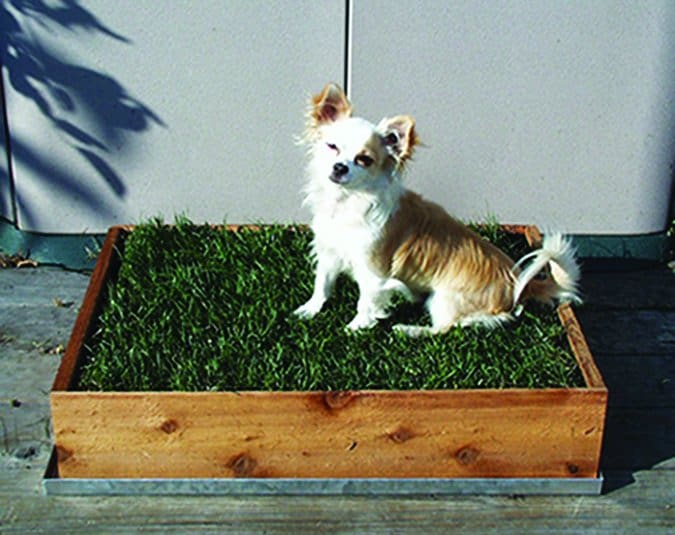
When they made an appointment to come see me for a private consult, it was for other behavioral issues – primarily the fear-related behaviors that resulted from a now two-year-old Midge’s lack of socialization in the puppy mill where she was born, and the pet store where she had grown up. They noted her house-soiling issues in the behavior intake form I asked them to complete, but were less concerned about that than the fear-based behavior that was escalating into biting. Recognizing that house soiling also put her at risk for losing her forever home, I convinced the Parkers that we needed to address both issues.
Reverse Crate Training
You can’t use a crate in the normal way to house train a dog who has learned to soil her bed. Normally, a dog – even a puppy – will try very hard not to soil the crate, so you confine them to prevent them from eliminating. Not so with Midge – in her mind she was supposed to eliminate in her crate. So we did the opposite: the Parkers started putting Midge in her crate only when they knew she had eliminated recently. At first they crated her for a maximum of 10 to 15 minutes, and then gave her supervised house freedom until her next bathroom break. Then she was back in the crate for a short spell. Gradually they lengthened her time in the crate, always removing her before she felt the need to eliminate, so she wouldn’t be tempted. If they had to leave her alone they left her in the bathroom, where she had a “legal” potty corner. The goal was to rebuild her natural inhibitions against soiling her bed.
I initially saw Midge some six months ago. It’s taking some time to resove her fear issues, but she’s made very happy progress in housetraining. She is now able to be crated for up to four hours during the day while her humans are away, and is immediately taken to eliminate outside when family or the pet sitter arrives at the home. She can be crated overnight in the Parker’s bedroom without a halftime potty break. She has been accident-free for the past four months, and is no longer supervised closely when loose in the house with her owners at home. The Parkers are delighted with her new house-training skills, and continue to work diligently to modify her fearfulness.
Teach Your Dog to Ring a Bell!
Some owners like to teach their dog to ring a bell as their bathroom signal. You can do this by teaching your dog to target her nose or paw to a bell suspended on a string from the doorknob, or to a button that causes a buzzer to go off.
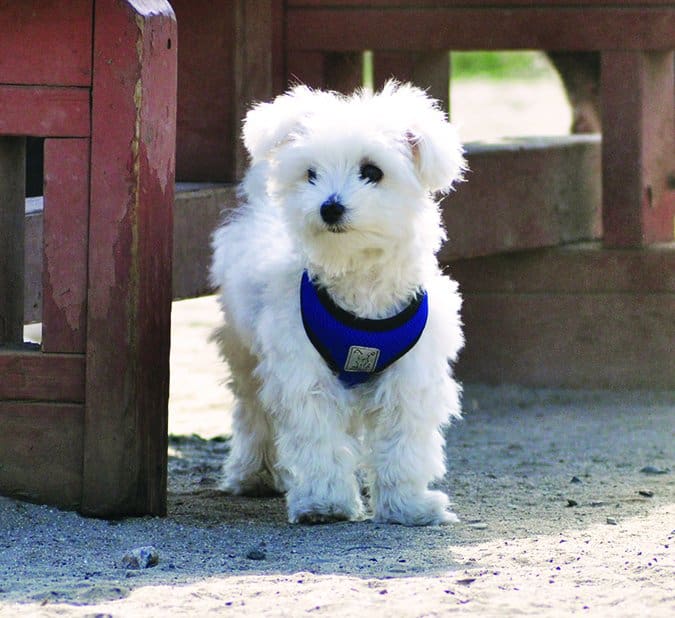
Nose:
This one is usually pretty easy, since dogs are likely to sniff a novel object that we present to them. Hold the bell in your hand and offer it to your dog. When she sniffs it (or sniffs near it) click your clicker (or use a verbal marker such as the word “Yes!”) and feed her a treat. Repeat until she is eagerly nudging the bell with her nose in order to get you to mark-and-treat. Add your “Want to go out?” cue just before you offer the bell for her to nudge. Now lower the bell an inch on its string, and click and treat for nudging. As you let the string get longer and longer, start only clicking nudges that are hard enough to make the bell jingle.
When she’ll consistently make it jingle at full string length, hang it on the doorknob and continue the lessons. When she can easily jingle the hanging bell on cue, start cueing it right before you take her out to potty. Gradually increase the distance you are from the door when you give the cue, and before long she’ll be offering the behavior on her own when she needs to go out.

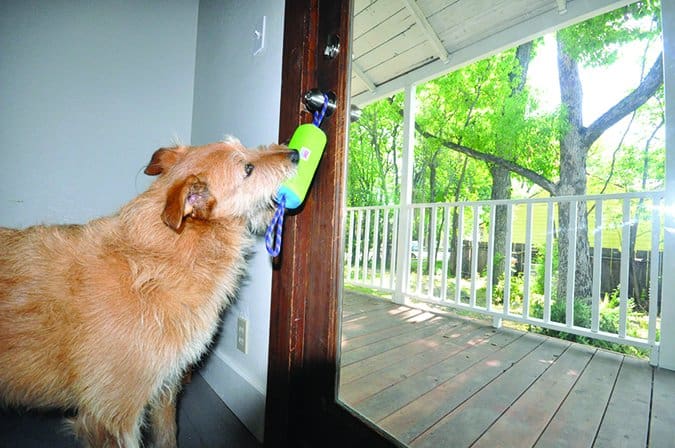
Paw:
If your dog already knows a cue for “Shake hands,” ask her to “Shake” while holding the bell in the palm of your hand. After a few of these, precede the “Shake” cue with your new “potty bell” cue, whatever you want that to be. In short order, she will tap the bell in your hand with her paw on the bathroom cue, and you can drop the “Shake” cue, reserving that for when you really want her to shake. Gradually lengthen the string and follow the directions above to teach her to paw the bell as her bathroom cue to you.
If your dog doesn’t already know a cue for “Shake hands,” you can prompt her to paw at your hand by holding a treat in your closed fist (click and treat!) until she offers the behavior easily, then transfer it to the bathroom bell. Or you can shape the behavior by clicking her for any paw movement at first, gradually clicking only for paw movements that come closer to ringing the bell, and eventually only for those that ring the bell.
Squeak:
Dogs who enjoy playing with squeaky toys may take to this alternative to bells. Use the shaping process described above to cue your dog to grab and squeak the toy, and then move the game to the door to your yard. With a zip-tie or string, fasten the squeaky toy to the door handle, at a height where it’s easy for your dog to reach and mouth it, but not low enough to make it easy to chew.
Pat Miller, CBCC-KA, CPDT-KA, CDBC, is WDJ’s Training Editor. She lives in Fairplay, Maryland, site of her Peaceable Paws training center, where she offers dog training classes and courses for trainers.



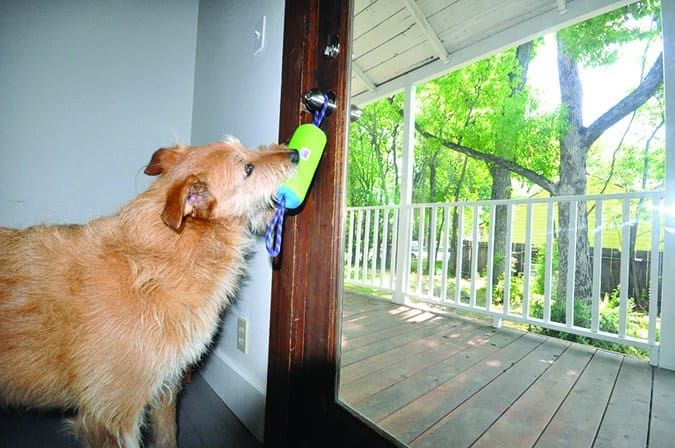
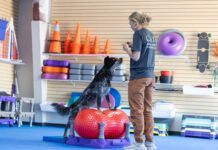


Thank you for such an informative article. It is good to know how long a dog should be left and ways to train them to show the need to go outside.
Michelle
http:\\milwaukiedogwalking.com
I have a Maltipoo and I am tired of him peeing and pooping all over the house I’m moving into an apartment and I need for him to learn to go outside I’m gone at least 8 hours in the day when I go to work I need help any suggestions
I have a 4 month old Labradoodle and have trained him to use the doggy door to go outside to pee/poo and I get excited and say Yes whenever he does either. While he seems to know to go outside, he will still poo in the house, normally behind a chair (I’m thinking b/c he knows it’s wrong). How can I curb him from still going in the house?